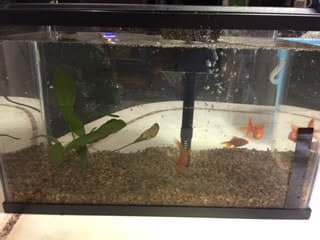pH Crash kills goldfish and Koi
pH Crash is a term we use when oxygen levels drop rapidly. Fish are seen gasping at the surface, however, within a short time are found dead or dying on the bottom. These same fish may have swollen or bleeding eyes. The pressure in the fish’s body rises rapidly as oxygen levels decline
pH dropping
Goldfish or Koi can be perfectly normal one day, and dead the next. How is it possible? Perhaps the surface is too quiet. Acting like a lid, a stagnant surface keeps oxygen from entering and Co2 from escaping. Maybe the water is too warm, the fish using more oxygen than normal, more than what’s available
Potential of hydrogen, abbreviated with pH is complicated, and not really a parameter at all, although it’s the parent of two; KH and O2. Indicating how healthy water is, these two parameters, carbonate mineral and oxygen combined make up the whole of pH
Carbonate mineral measures the alkalinity and acidity of water. Responsible for alkalinity, KH supports the oxygen molecule, giving water the possibility of being oxygenated, however, it takes more than a healthy alkalinity level in order for water to support O2. Water must be clear of clouds and gases as well as having a healthy KH. Oxygen needs space
Where does oxygen come from?
Many a fish keeper has buffered alkalinity in an attempt to raise pH, a deadly mistake. Like ammonia, KH causes burns, causing the inner gills to become inflamed. Inflamed gills deprive the blood of oxygen, causing the fish to suffocate. Buffering pH without testing KH first can result in severe injury or death
Our fish deserve excellent water quality, so why settle for okay readings?
COMFORT ZONES
(high side of the zone preferred)
pH: 7.4 to 8.4
KH: 90 to 120 to 140 ppm
The aquarium in the photo below has an open top, and two pond pumps placed at each end of the tank. The action expels Co2 and pulls oxygen from the surface above. There’s no risk here of a pH crash

Many a pH crash occurs when water is stagnant. The parameters might be excellent, but a quiet surface is as good as putting a lid on your tank or pond, keeping oxygen from entering, and Co2 (gas created from waste) from escaping. Avoid the risk by getting that water moving. If your tank is enclosed, flip your lip
KH and pH parallel each other’s performance if oxygen is not being blocked from entering the water
KH pH
50 ppm 6. ppm
60 ppm 6.5 ppm
70 ppm 7. ppm (neutral zone)
80 ppm 7.5 ppm
90 ppm 7,8 ppm
100 ppm 8.0 ppm
120 ppm 8.2 ppm

The fish in the photo above are in an enclosed aquarium with little water movement. Carbonate mineral levels are healthy, but pH has crashed, leading to a dangerous environment
Oxygenating water
All rights reserved
Author: Brenda Rand